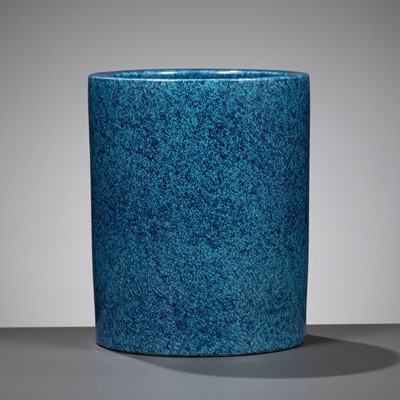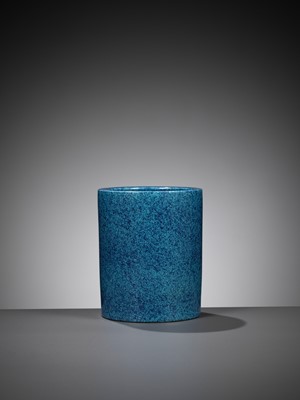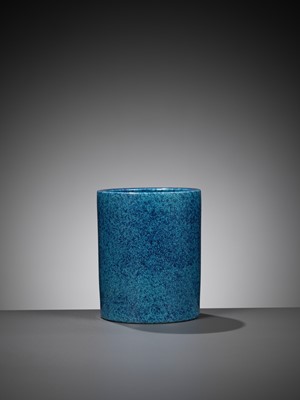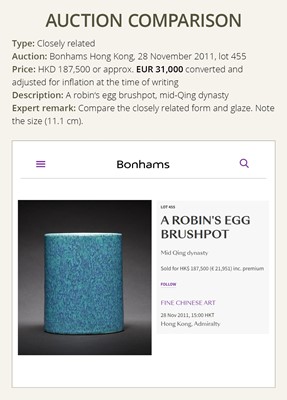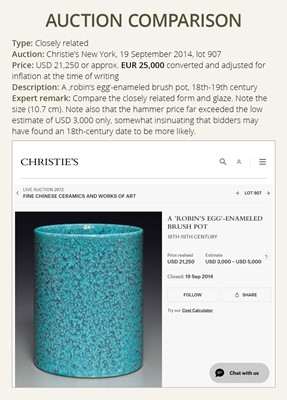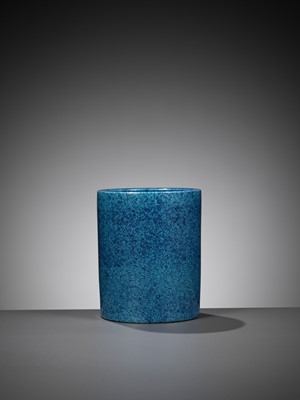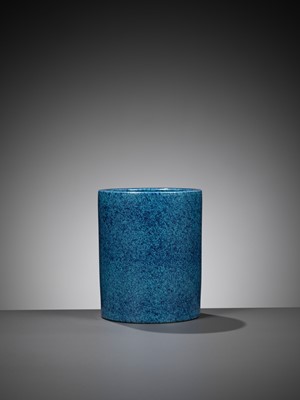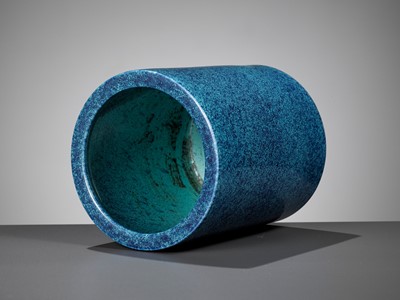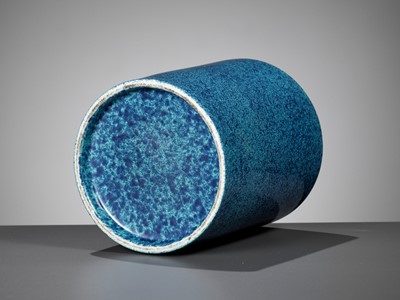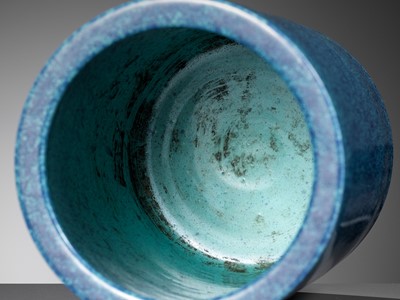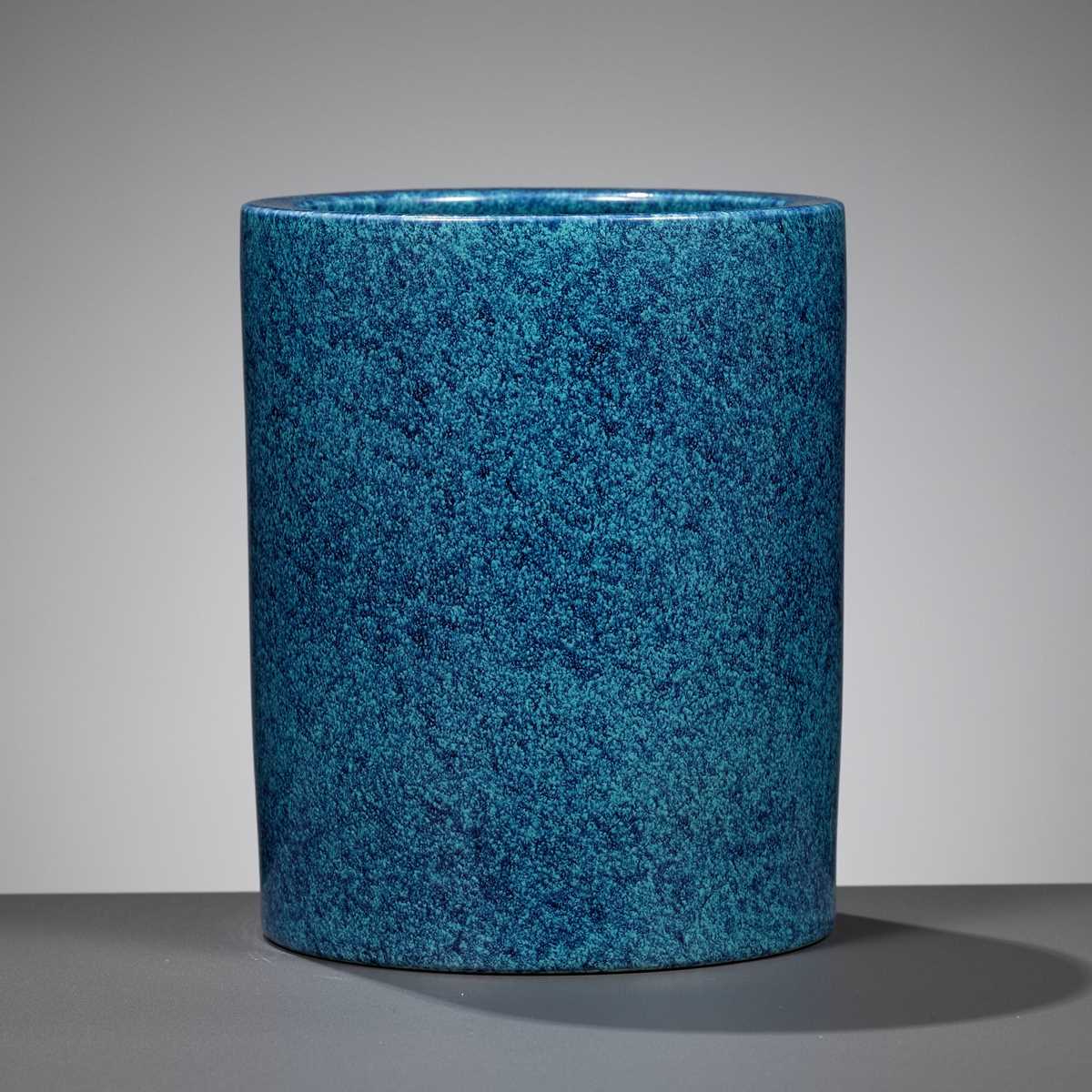9th Mar, 2023 13:00
TWO-DAY AUCTION - Fine Chinese Art / 中國藝術集珍 / Buddhism & Hinduism
115
A ROBIN'S EGG GLAZED BRUSHPOT, BITONG, 18TH CENTURY
十八世紀爐鈞釉筆筒
Sold for €1,950
including Buyer's Premium
China. Of cylindrical form with straight sides rising to an incurved rim, and supported on a tall, gently rounded and unglazed foot, applied all over with a mottled turquoise and blue glaze.
Provenance: British trade.
Condition: Very good condition with expected wear to glaze, few traces of use, and small manufacturing flaws. Some black ink stains to the interior, probably from previous usage as a brush pot.
Weight: 689.3 g
Dimensions: Height 13.1 cm
The ‘Robin’s egg’ glaze represents a significant technical innovation of the Yongzheng period (1723-35) attributable to Tang Ying (1682-1756), the greatest porcelain superintendent in Chinese history. The Yongzheng Emperor, who initiated many revivals of earlier ceramic techniques, was particularly enamored with the variegated Jun glazes of the Song (960-1279) and Ming (1368-1644) dynasties. In order to have the glazes recreated or imitated, Tang Ying sent his trusted assistant from the imperial kilns in Jingdezhen, Jiangxi province, on study trips to the Jun region in Henan province to learn from the local potters and even went as far as having ceramic raw materials mined in the Jun area transported over thousands of kilometers to Jingdezhen. Among the many types of glazes derived from those efforts are mottled purple ones such as the flambé variety, and mottled turquoise ones such as ‘robin’s egg’, which Tang Ying termed Lu Jun or Oven Jun, i.e., a Jun glaze fired in low-temperature ovens instead of high-temperature kilns (see Jingdezhen Institute of Ceramic Archaeology et al, The Cultures of Porcelain Superintendents and Jingdezhen, conference volume, Nanchang, 2011). The ‘robin’s egg’ glaze is mentioned on a stele in Jingdezhen, inscribed by Tang Ying, as one of the major types of ceramics that he succeeded in firing and proposed as suitable for regular delivery to the Imperial court. Its color is described as intermediate between the glazes of the Shiwan kilns of Foshan, Guangdong, and those used by the Yixing kilns in Jiangsu for their zisha tea pots, but having a better and more beautiful flow.
Auction result comparison:
Type: Closely related
Auction: Bonhams Hong Kong, 28 November 2011, lot 455
Price: HKD 187,500 or approx. EUR 31,000 converted and adjusted for inflation at the time of writing
Description: A robin's egg brushpot, mid-Qing dynasty
Expert remark: Compare the closely related form and glaze. Note the size (11.1 cm).
Auction result comparison:
Type: Closely related
Auction: Christie’s New York, 19 September 2014, lot 907
Price: USD 21,250 or approx. EUR 25,000 converted and adjusted for inflation at the time of writing
Description: A 'robin's egg'-enameled brush pot, 18th-19th century
Expert remark: Compare the closely related form and glaze. Note the size (10.7 cm). Note also that the hammer price far exceeded the low estimate of USD 3,000 only, somewhat insinuating that bidders may have found an 18th-century date to be more likely.
十八世紀爐鈞釉筆筒
中國,圓筒形,口部微寬於足部,淺圈足,器形小巧。筆筒通體遍施爐鈞釉,釉汁自然流淌,繁密斑駁,呈現藍、紫和綠色。
來源:英國古玩交易。
品相:品相極好,釉面有磨損,輕微使用痕跡與製造缺陷。內部有一些黑色墨水漬,可能是以前用作筆筒時留下的。
重量:689.3 克
尺寸:高13.1 厘米
爐鈞釉創於清雍正年間,盛行於雍正、乾隆二朝,歸功於中國歷史上最偉大的瓷器主管唐英(1682-1756 年)。多次復興早期陶瓷技術的雍正皇帝特別喜歡宋朝(960-1279 年)和明朝(1368-1644 年)的雜色鈞釉。為了重製或仿製釉料,唐英派江西景德鎮御窯親信到河南鈞州學習,向當地陶藝家學習,甚至還製作了陶器。 鈞區開采的原材料,千里迢迢運到景德鎮。在這些努力衍生出的眾多類型的釉中,有斑駁的紫色釉料,如窯變釉,以及斑駁的綠松石釉料,如爐鈞釉,因低溫爐內燒成仿宋鈞釉而得其名。釉中含有粉劑,故而釉厚不透明。釉面結晶呈色多種,深淺不一,可呈現之顏色有紅,藍,紫,綠,月白等,並熔於一體。
拍賣結果比較:
形制:非常相近
拍賣:香港邦瀚斯,2011年11月28日,lot 455
價格:HKD 187,500(相當於今日EUR 31,000)
描述:清中期爐鈞釉筆筒
專家評論:比較非常相近的外形和釉面。請注意尺寸(11.1 厘米)。
拍賣結果比較:
形制:非常相近
拍賣:紐約佳士得,2014年9月19日,lot 907
價格:USD 21,250(相當於今日EUR 25,000)
描述:清十八至十九世紀爐鈞釉筆筒
專家評論:比較非常相近的外形和釉面。請注意尺寸(10.7 厘米)。請注意此筆筒的落槌價遠高於估價USD 3,000,可能有買家發現此筆筒可能為十八世紀。
China. Of cylindrical form with straight sides rising to an incurved rim, and supported on a tall, gently rounded and unglazed foot, applied all over with a mottled turquoise and blue glaze.
Provenance: British trade.
Condition: Very good condition with expected wear to glaze, few traces of use, and small manufacturing flaws. Some black ink stains to the interior, probably from previous usage as a brush pot.
Weight: 689.3 g
Dimensions: Height 13.1 cm
The ‘Robin’s egg’ glaze represents a significant technical innovation of the Yongzheng period (1723-35) attributable to Tang Ying (1682-1756), the greatest porcelain superintendent in Chinese history. The Yongzheng Emperor, who initiated many revivals of earlier ceramic techniques, was particularly enamored with the variegated Jun glazes of the Song (960-1279) and Ming (1368-1644) dynasties. In order to have the glazes recreated or imitated, Tang Ying sent his trusted assistant from the imperial kilns in Jingdezhen, Jiangxi province, on study trips to the Jun region in Henan province to learn from the local potters and even went as far as having ceramic raw materials mined in the Jun area transported over thousands of kilometers to Jingdezhen. Among the many types of glazes derived from those efforts are mottled purple ones such as the flambé variety, and mottled turquoise ones such as ‘robin’s egg’, which Tang Ying termed Lu Jun or Oven Jun, i.e., a Jun glaze fired in low-temperature ovens instead of high-temperature kilns (see Jingdezhen Institute of Ceramic Archaeology et al, The Cultures of Porcelain Superintendents and Jingdezhen, conference volume, Nanchang, 2011). The ‘robin’s egg’ glaze is mentioned on a stele in Jingdezhen, inscribed by Tang Ying, as one of the major types of ceramics that he succeeded in firing and proposed as suitable for regular delivery to the Imperial court. Its color is described as intermediate between the glazes of the Shiwan kilns of Foshan, Guangdong, and those used by the Yixing kilns in Jiangsu for their zisha tea pots, but having a better and more beautiful flow.
Auction result comparison:
Type: Closely related
Auction: Bonhams Hong Kong, 28 November 2011, lot 455
Price: HKD 187,500 or approx. EUR 31,000 converted and adjusted for inflation at the time of writing
Description: A robin's egg brushpot, mid-Qing dynasty
Expert remark: Compare the closely related form and glaze. Note the size (11.1 cm).
Auction result comparison:
Type: Closely related
Auction: Christie’s New York, 19 September 2014, lot 907
Price: USD 21,250 or approx. EUR 25,000 converted and adjusted for inflation at the time of writing
Description: A 'robin's egg'-enameled brush pot, 18th-19th century
Expert remark: Compare the closely related form and glaze. Note the size (10.7 cm). Note also that the hammer price far exceeded the low estimate of USD 3,000 only, somewhat insinuating that bidders may have found an 18th-century date to be more likely.
十八世紀爐鈞釉筆筒
中國,圓筒形,口部微寬於足部,淺圈足,器形小巧。筆筒通體遍施爐鈞釉,釉汁自然流淌,繁密斑駁,呈現藍、紫和綠色。
來源:英國古玩交易。
品相:品相極好,釉面有磨損,輕微使用痕跡與製造缺陷。內部有一些黑色墨水漬,可能是以前用作筆筒時留下的。
重量:689.3 克
尺寸:高13.1 厘米
爐鈞釉創於清雍正年間,盛行於雍正、乾隆二朝,歸功於中國歷史上最偉大的瓷器主管唐英(1682-1756 年)。多次復興早期陶瓷技術的雍正皇帝特別喜歡宋朝(960-1279 年)和明朝(1368-1644 年)的雜色鈞釉。為了重製或仿製釉料,唐英派江西景德鎮御窯親信到河南鈞州學習,向當地陶藝家學習,甚至還製作了陶器。 鈞區開采的原材料,千里迢迢運到景德鎮。在這些努力衍生出的眾多類型的釉中,有斑駁的紫色釉料,如窯變釉,以及斑駁的綠松石釉料,如爐鈞釉,因低溫爐內燒成仿宋鈞釉而得其名。釉中含有粉劑,故而釉厚不透明。釉面結晶呈色多種,深淺不一,可呈現之顏色有紅,藍,紫,綠,月白等,並熔於一體。
拍賣結果比較:
形制:非常相近
拍賣:香港邦瀚斯,2011年11月28日,lot 455
價格:HKD 187,500(相當於今日EUR 31,000)
描述:清中期爐鈞釉筆筒
專家評論:比較非常相近的外形和釉面。請注意尺寸(11.1 厘米)。
拍賣結果比較:
形制:非常相近
拍賣:紐約佳士得,2014年9月19日,lot 907
價格:USD 21,250(相當於今日EUR 25,000)
描述:清十八至十九世紀爐鈞釉筆筒
專家評論:比較非常相近的外形和釉面。請注意尺寸(10.7 厘米)。請注意此筆筒的落槌價遠高於估價USD 3,000,可能有買家發現此筆筒可能為十八世紀。
Zacke Live Online Bidding
Our online bidding platform makes it easier than ever to bid in our auctions! When you bid through our website, you can take advantage of our premium buyer's terms without incurring any additional online bidding surcharges.
To bid live online, you'll need to create an online account. Once your account is created and your identity is verified, you can register to bid in an auction up to 12 hours before the auction begins.
Intended Spend and Bid Limits
When you register to bid in an online auction, you will need to share your intended maximum spending budget for the auction. We will then review your intended spend and set a bid limit for you. Once you have pre-registered for a live online auction, you can see your intended spend and bid limit by going to 'Account Settings' and clicking on 'Live Bidding Registrations'.
Your bid limit will be the maximum amount you can bid during the auction. Your bid limit is for the hammer price and is not affected by the buyer’s premium and VAT. For example, if you have a bid limit of €1,000 and place two winning bids for €300 and €200, then you will only be able to bid €500 for the rest of the auction. If you try to place a bid that is higher than €500, you will not be able to do so.
Online Absentee and Telephone Bids
You can now leave absentee and telephone bids on our website!
Absentee Bidding
Once you've created an account and your identity is verified, you can leave your absentee bid directly on the lot page. We will contact you when your bids have been confirmed.
Telephone Bidding
Once you've created an account and your identity is verified, you can leave telephone bids online. We will contact you when your bids have been confirmed.
Classic Absentee and Telephone Bidding Form
You can still submit absentee and telephone bids by email or fax if you prefer. Simply fill out the Absentee Bidding/Telephone bidding form and return it to us by email at office@zacke.at or by fax at +43 (1) 532 04 52 20. You can download the PDF from our Upcoming Auctions page.
How-To Guides
How to Create Your Personal Zacke Account
How to Register to Bid on Zacke Live
How to Leave Absentee Bids Online
How to Leave Telephone Bids Online
中文版本的操作指南
创建新账号
注册Zacke Live在线直播竞拍(免平台费)
缺席投标和电话投标
Third-Party Bidding
We partner with best-in-class third-party partners to make it easy for you to bid online in the channel of your choice. Please note that if you bid with one of our third-party online partners, then there will be a live bidding surcharge on top of your final purchase price. You can find all of our fees here. Here's a full list of our third-party partners:
- 51 Bid Live
- EpaiLive
- ArtFoxLive
- Invaluable
- LiveAuctioneers
- the-saleroom
- lot-tissimo
- Drouot
Please note that we place different auctions on different platforms. For example, in general, we only place Chinese art auctions on 51 Bid Live.
Bidding in Person
You must register to bid in person and will be assigned a paddle at the auction. Please contact us at office@zacke.at or +43 (1) 532 04 52 for the latest local health and safety guidelines.
